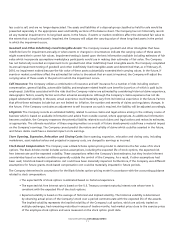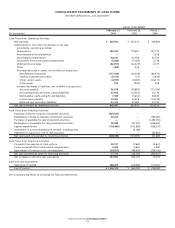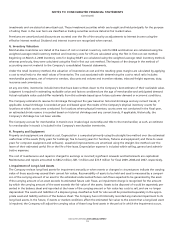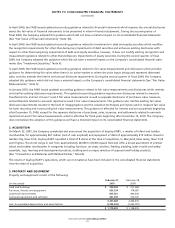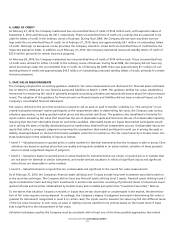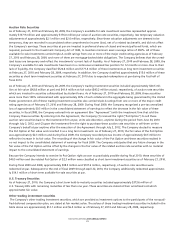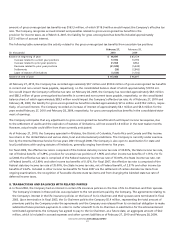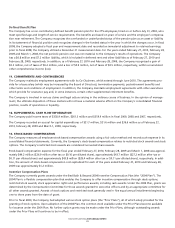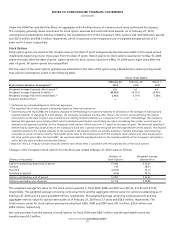Bed, Bath and Beyond 2009 Annual Report Download - page 22
Download and view the complete annual report
Please find page 22 of the 2009 Bed, Bath and Beyond annual report below. You can navigate through the pages in the report by either clicking on the pages listed below, or by using the keyword search tool below to find specific information within the annual report.
BED BATH & BEYOND 2009 ANNUAL REPORT
20
NOTES TO CONSOLIDATED FINANCIAL STATEMENTS
(continued)
are recorded as a reduction of sales. Shipping and handling fees that are billed to a customer in a sale transaction are recorded
in sales. Taxes, such as sales tax, use tax and value added tax, are not included in sales.
Revenues from gift cards, gift certificates and merchandise credits are recognized when redeemed. Gift cards have no provisions
for reduction in the value of unused card balances over defined time periods and have no expiration dates, but are subject to
state escheat regulations; as such, the Company does not record income associated with unredeemed gift cards.
Sales returns are provided for in the period that the related sales are recorded based on historical experience. Although the
estimate for sales returns has not varied materially from historical provisions, actual experience could vary from historical
experience in the future if the level of sales return activity changes materially. In the future, if the Company concludes
that an adjustment to the sales return accrual is required due to material changes in the returns activity, the reserve will be
adjusted accordingly.
P. Cost of Sales
Cost of sales includes the cost of merchandise, buying costs and costs of the Company’s distribution network including inbound
freight charges, distribution facility costs, receiving costs, internal transfer costs and shipping and handling costs.
Q. Vendor Allowances
The Company receives allowances from vendors in the normal course of business for various reasons including direct coopera-
tive advertising, purchase volume and reimbursement for other expenses. Annual terms for each allowance include the basis for
earning the allowance and payment terms which vary by agreement. All vendor allowances are recorded as a reduction of inven-
tory cost, except for direct cooperative advertising allowances which are specific, incremental and identifiable. The Company
recognizes purchase volume allowances as a reduction of the cost of inventory in the quarter in which milestones are achieved.
Advertising costs were reduced by direct cooperative allowances of $14.5 million, $14.9 million and $11.1 million for fiscal 2009,
2008 and 2007, respectively.
R. Store Opening, Expansion, Relocation and Closing Costs
Store opening, expansion, relocation and closing costs, including markdowns, asset residual values and projected occupancy
costs, are charged to earnings as incurred.
S. Advertising Costs
Expenses associated with direct response advertising are expensed over the period during which the sales are expected to
occur, generally four to six weeks, and all other expenses associated with store advertising are charged to earnings as incurred.
Net advertising costs amounted to $230.6 million, $266.4 million and $239.6 million for fiscal 2009, 2008 and 2007, respectively.
T. Stock-Based Compensation
The Company measures all employee stock-based compensation awards using a fair value method and records such expense
in its consolidated financial statements. The Company adopted the accounting guidance related to stock compensation on August
28, 2005 (the “date of adoption”) under the modified prospective application. Under this application, the Company records stock-
based compensation expense for all awards granted on or after the date of adoption and for the portion of previously granted
awards that remained unvested at the date of adoption. Currently, the Company’s stock-based compensation relates to restricted
stock awards and stock options. The Company’s restricted stock awards are considered nonvested share awards.
U. Income Taxes
The Company files a consolidated Federal income tax return. Income tax returns are also filed with each taxable jurisdiction
in which the Company conducts business.
The Company accounts for its income taxes using the asset and liability method. Deferred tax assets and liabilities are recognized
for the future tax consequences attributable to the differences between the financial statement carrying amounts of existing
assets and liabilities and their respective tax bases and operating loss and tax credit carryforwards. Deferred tax assets and liabili-
ties are measured using enacted tax rates expected to apply to taxable income in the year in which those temporary differences
are expected to be recovered or settled. The effect on deferred tax assets and liabilities of a change in tax rates is recognized in
earnings in the period that includes the enactment date.



